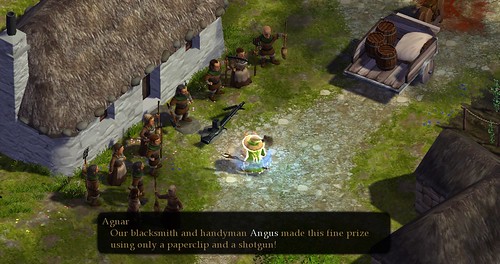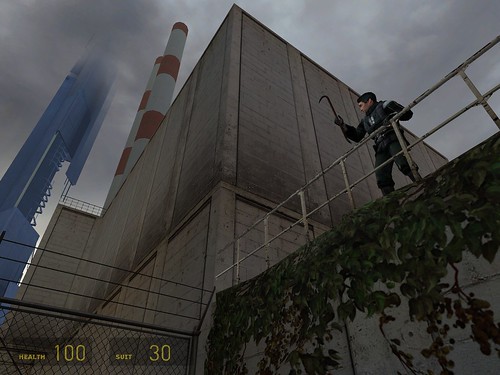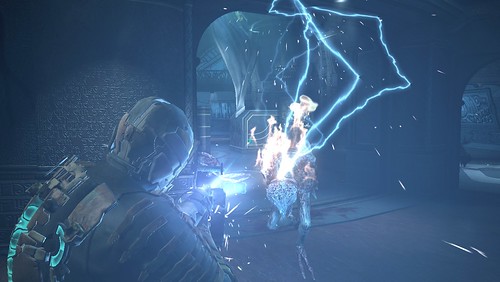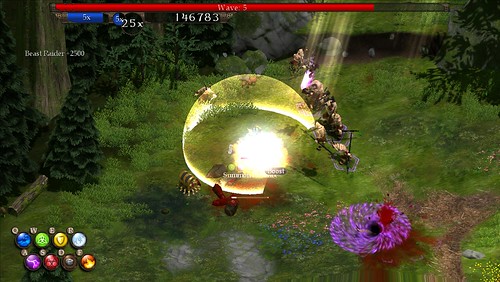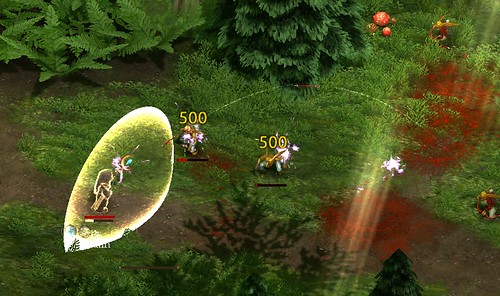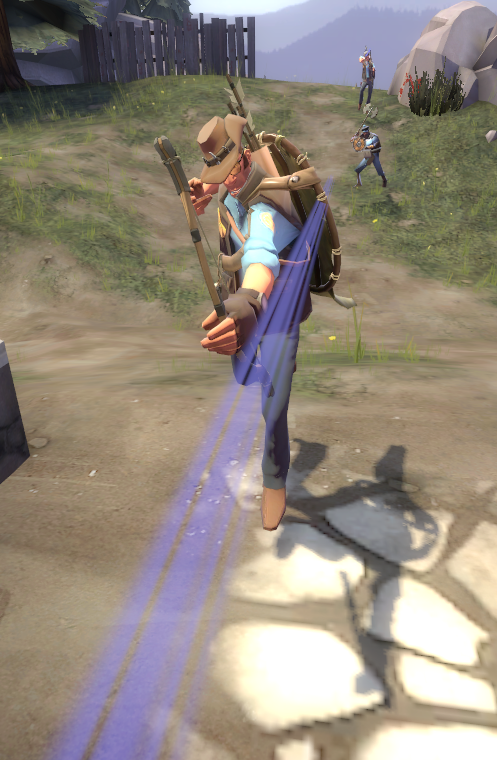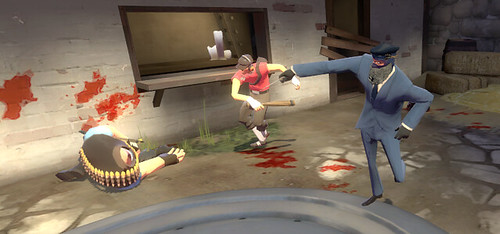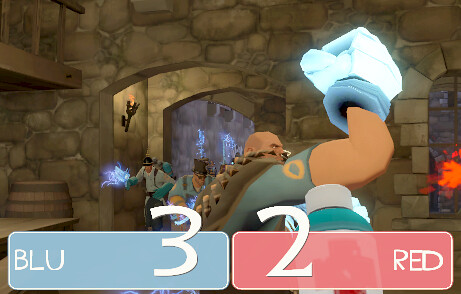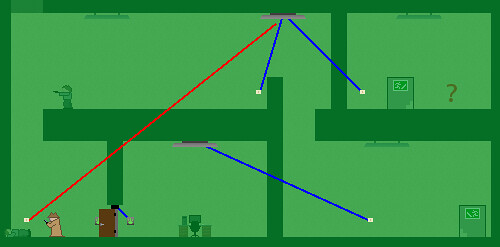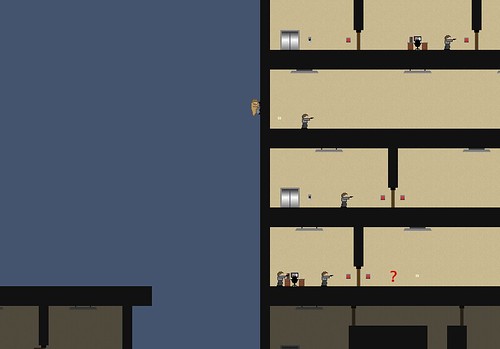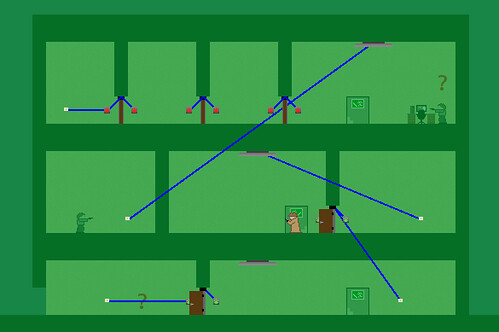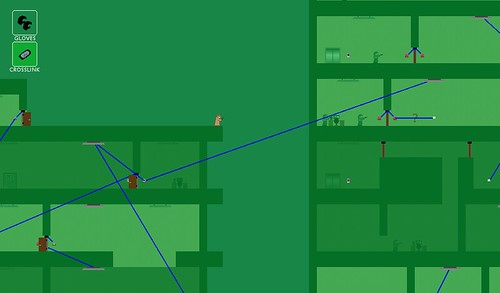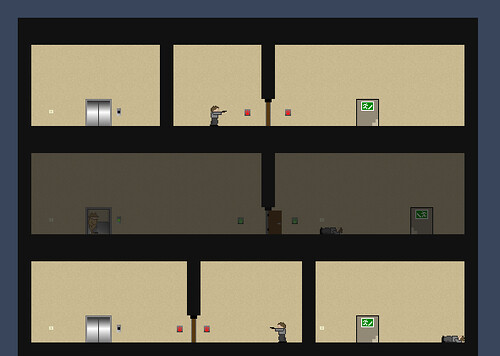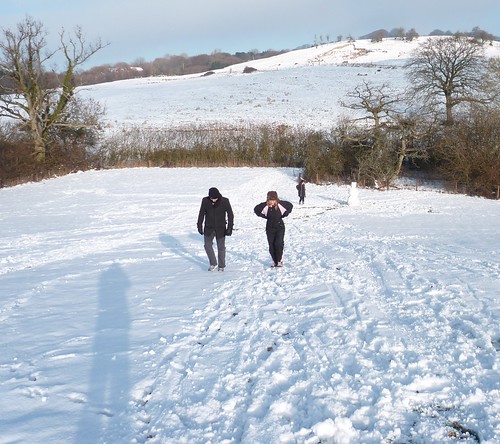TOM FRANCIS
REGRETS THIS ALREADY
Hello! I'm Tom. I'm a game designer, writer, and programmer on Gunpoint, Heat Signature, and Tactical Breach Wizards. Here's some more info on all the games I've worked on, here are the videos I make on YouTube, and here are two short stories I wrote for the Machine of Death collections.
Theme
By me. Uses Adaptive Images by Matt Wilcox.
Search
The Podcast Of My Machine Of Death Story Is Out
The stories from the Machine of Death collection are being gradually released as a free podcast, a sort of episodic audiobook. Mine just came out, read rather excellently by Christopher Joseph. Warning! Strong language from the first word. Continued
Mixtape: Ten Tracks Mostly From 2010
About the only new music I got into in 2010 was Said the Gramaphone’s round-up of the best music of 2009. So a while back, I asked Twitter for help, scoured The Onion AV Club, sifted through Spotify lists, and then pretty much went with Said the Gramaphone’s round-up of the best music of 2010.
Since I’m embedding a bunch of tracks from their site, I’ll also copy their referral codes for the buy links so any kickbacks go to them. Continued
How Fast Should Stuff Unlock?
The game Magicka unlocks eight different elements in its ten minute playable intro, giving you access to 16,384 spell combinations.
Half-Life 1 and 2 don’t give you any abilities in the first ten minutes, and in general only grant you about one new weapon type every hour or two.
Obviously it depends partly on genre, but there’s more than that going on. I think developers fundamentally disagree on the question of “How far through the game should I get access to the main abilities that make it great?”
Every hour before that point, you lose some players who might have liked it if they’d got that far. I’m probably never going to get through Dead Space 2 because I’ve been playing for hours and still only have two weapons, one unexciting and the other impractical.
But every hour after that point, the player has a less exciting sense of progression, and risks getting bored with the same formula. FEAR probably fell victim to that – if you didn’t love the basic combat as much as I did, the fact that it never changed after the first few levels probably killed it.
Personally, I like to get things one at a time, but quickly early on. I will play almost anything if my toolset is changing every ten minutes.
The games that pace their unlocks slower tend to frontload the experience with a lot of scripted or story content, unique stuff that’s hard to make.
I think that’s rarely as compelling and inviting to the player as getting new abilities. I’d rather they saved the unique, story-driven stuff for after I’ve got all my tools, to stop that phase from getting repetitive. By that point I’m probably invested enough to pay more attention to it, whereas early on it’s usually unwanted noise.
What’s your sweet spot? What games do it well, and which ones don’t? I’m asking partly because this is one of the big things I haven’t decided about Gunpoint yet.
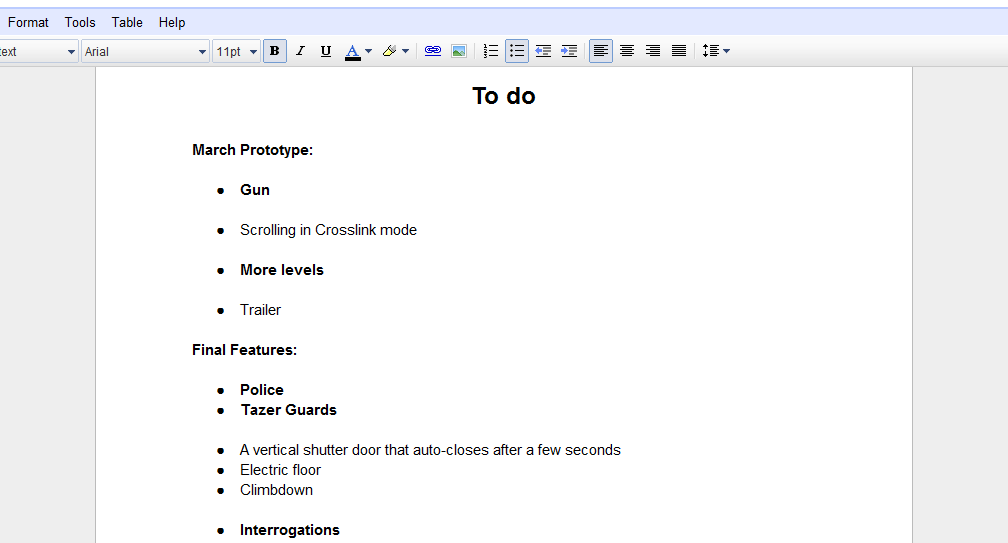
How I Am Working
Gunpoint is going amazingly well. I’ve been splitting what’s left to do into little monthly task lists, and I’ve already finished everything I had down for March. I started making the game in May last year, and said I didn’t want it to take more than a year. So my aim is to release it this May. Expect it in July.
I typically only work on it about one weekend a month, and I forgot about it completely for two months last year. The two days I spent on it during the holidays shot it forwards to a really exciting point, and the feedback from testers on that version was amazing. So lately I’ve been spending about a third of my spare time on it – what we in the lazy industry call ‘crunch’. Continued
Better Spelling In Magicka
Magicka is great. You’re a wizard who casts spells by summoning any combination of eight different magical elements into your staff, then releasing them either as a quick blast, a charged shot, an area of effect around you, an enchantment for your weapon, or directly onto yourself. Accordingly, there’s a crazy level of player freedom, very few limits to your power, and a great, great many ways to instantly kill yourself by applying the wrong powers to the wrong thing.
Because you need to combine those eight elements so frequently, they’re on the WASD keys where movement controls would normally be. More specifically, they’re assigned like this:
Remembering what’s what is crucial and takes some time to pick up. So I can’t help thinking that, for the English version of the game at least, it might have made more sense to assign them like this:
W – Water
E – Electricity
R – Restoration
A – Arcane
S – Shield
D – Dirt
F – Fire
Q and D aren’t perfect, but there’s enough consonance to make the association memorable, I think. You can reassign all of these manually, but because the game still displays them in the old order on-screen at all times, you’d have to relearn it while trying to ignore ever-present misinformation of their relative positions, so it isn’t worth it.
The fun thing about Magicka is, ironically, that there’s no concept of magicka or mana in it – however mighty a spell you cook up, you can cast it as quickly and as often as you can press the right buttons. It changes the concept of magic from what it is in most RPGs – fantasy guns, with fantasy ammo. Here it’s just palette of abilities, with curious but reliable rules about how they interact and combine. It feels like what magic should be.
I mentioned there’s lots of ways to kill yourself – using lightning when you’re wet, firing an arcane beam at a shield, forgetting to heal before you use fire to dry yourself. In multiplayer, they’re increased exponentially. Even trying to heal one of your friends when they’re using the wrong spell can cause them to explode. There’s merciless friendly fire, so area of effect stuff frequently shreds everyone on your team, boulders smash them out of the level, and lightning leaps from enemies to friends indifferently.
But the good stuff also gets more interesting: the most satisfying spells involve the Arcane element, which gives the attack the form of a beam that ultimately explodes whatever it kills. In co-op, you can intentionally cross these beams so that they combine into a more powerful one, shooting off in a direction that’s democratically controlled by where each of you are trying to point it. It’s like a weaponised version of moving your hands on a Ouija board. Again: magic like it ought to be.
The bit I most enjoy about playing a new game is after I’ve discovered enough possibilities to be excited, but before I’ve discovered them all. Magicka seems to exist entirely in that period – you grasp what’s cool about it in seconds, but days later I’m still not sure of the best way to execute my most common attack.
Right now I summon water, summon fire to turn it to steam, combine steam with arcane to turn it into a burning beam, then electrify that beam so that as the superheated steam soaks my target, the lightning does double damage as it electrocutes them.
But now I hear you can summon a rock, douse it in water, and use that as a super-soaker to get all your enemies wet. And once they are, an arcane beam that’s imbued with both lightning and cold does even more damage – freezing a wet target triples the damage it takes while electrocution also doubles it, and has the added bonus of slowing them to a crawl.
This is giving me new ideas for my defense spells: right now I use an area-effect shield to create a bubble around myself, then stand at the edge of it and mix water and shields to create an arc of rainclouds just outside the bubble. Once the enemies are wet, I mix lightning and shields to create stormclouds that electrocute them all. But perhaps I could be creating a frost arc with that same method, hurting them more and slowing the rate they break down my shield?
Everything you can concoct in Magicka can be cast in five different ways – a quick blast, a charged blast, an area effect around you, directly onto yourself (often a bad idea), or into your weapon, making its next hit deliver the magical damage the spell normally would. Casting a shield on your sword causes it to shoot out a long barrier, dividing groups of enemies in two. It’s that mix of logic and nonsense that makes experimenting with this system exciting.
Unfortunately, right now, getting it working is as dark and erratic an art as playing it. Hilariously, some machines crash whenever beams are crossed in multiplayer. Others behave as if they have an ancient videocard, multiplayer is hard to get into. The single player is also hurt by some really stupid use of checkpoints over proper savegames. But it is only £8, and the devs are keeping to their promise of daily patches.
Advice
This section of preaching is directed at me rather than you, but I want to write it publicly to force myself to make sense. I’ll probably include some irrelevant music or photos with each post to distract you in case you get bored – this one’s the first big win of 2011’s adventure into the music other people discovered in 2010. Continued
How I Feel About Team Fortress 2 In Graph Form
Lately, I’ve been playing and enjoying TF2 a bit. There was a time when I wrote about that game so often this site was virtually a fan blog, but it petered out a bit. It’s a combination of the natural drop off in interest in a competitive online game, and a drop off in the interesting differences the new content adds.
The latest update has bucked the trend a bit, but before I get into why, I want to explain what I’m talking about. I often wonder why my play time with TF2 dropped off even as the stuff in it got much better, so I have expressed the relationship in the only way I know how to articulate any feelings: through the medium of graph.

Basically, I wouldn’t normally like a team-based shooter at all by this point in its life cycle, and that can’t help but have an influence. I don’t like competition because I’m too competitive, and I don’t like team games because I don’t like organising people. It’s a miracle I like TF2 at all.
The chunks of new content flying into the game have kept it fresher than it had any right to be, often because it genuinely made the game better, and the rest of the time just because it was new. That appeal ended with the money update: once they added a way to buy new stuff for cash, they no longer provided an easy route to get it for free. It ceased to be “Ooh, new stuff!” and became “Hmm, purchasing options.”
But the last update does have that kick of novelty: it’s a medieval mode where most classes are useless, since their high tech weapons are gone.
Only the sword-and-shield Demoman and the bow-firing Sniper are great, and a few other classes can work if they happen to unlock certain new items, like gloves that make the Heavy tougher against ranged attacks, or a healing crossbow for the Medic. What I like about it is this:
1. It’s very, very different.
2. It’s so new no-one really cares about winning yet.
3. No-one can bitch at me for going Sniper when we already have five Snipers.
4. The only map for it is small, focused, and channels people into a beautifully designed chokepoint for the finale.
5. No sentries.
6. No stickies.
I’m fine with getting skewered by an arrow, fine with having my head cut off, fine with being battered to death by a Heavy’s metal fists. Almost every other way to die in TF2, particularly by automated sentry fire, is just irritating to me. Nothing to do with the skill involved or lack thereof, it just feels annoying.
This mode pares back all of the ways to die instantly to a distant opponent, and so for the first time, my cause of death isn’t always “Walked round a corner, met three enemies”.
How long it’ll stay fun I don’t know, but variety like this is what I want from this game now. I think there’s as much value in taking things out as putting them in.
Gunpoint: The Mechanic
The game I’m making is about infiltration, but I’ve held off mentioning the way you do it until it’s actually in the game. It is now, and on Saturday night I sent it to around one hundred testers who kindly agreed to try it out. This was a little nerve wracking.
Before I go any further, if you signed up to test the latest version but haven’t played it yet, I’d really like you to play it before you read this. The reason I haven’t mentioned it before is that I wanted the first people to play it to do so fresh, to see if it makes sense without any external explanation.
It’s a tool called the Crosslink, which lets you rewire any device in the level to any other. So if there’s an electronically locked security door you want to open, you can use the Crosslink to wire a light switch to it, then press the switch to open the door.
But you don’t have to be the one who presses the switch: guards will use security hand scanners to open those doors, and hit light switches if they find themselves in the dark. So you can rewire those things to screw with them: a guard tries to turn the lights back on and finds it slams a door shut and traps him in the room. Trying to open it unlocks another door halfway across the level, letting the player into the building.
The idea is to give the player a lot of freedom to tinker with their environment and fuck with people. I wanted a system that gives you enough power that you can be creative, think of approaches that I hadn’t considered, and come up with your own way of playing. And I wanted a game where killing a guy is not the most interesting thing you can do to him.
Games that funnel you down a single path seem to be made from a perspective of, “What if the player is stupid? How can we make sure he can complete this?” I wanted to start from the question, “What if the player is smarter than me? How can I make something even he’ll enjoy?” I still want the barrier to entry to be low, but I don’t want it to double as a ceiling on the intricacy of what you can do.
The results are making me very happy. I built a crude demo record/playback function into this prototype, so testers can send me a replay of their first attempt at the game, and I can watch how they dealt with each level. My plan was to see where the stumbling blocks were, what players tried to do but couldn’t, or didn’t try but could have. But it also shows the awesome solutions they came up with.
In the last one I watched, the player seems to rewire a building all wrong. I’m scratching my head when he hits a lightswitch, which isn’t connected to anything more interesting than a light. But a guard on that floor is by another switch, which he hits.
Instead of turning the light back on, it turns off the light on the top floor, causing the guard up there to open several security doors on the way to turn it back on. When he finally presses it, instead of the light coming back on, the door slams and locks behind him. The player just shuffles up the stairs and hacks the terminal he was trying to get to, while every guard on the level is trapped in a different darkened room.
That’s not the quickest or easiest way to do that level, nor one I’d ever tried, but it’s awesome to see people come up with their own plans. Early on, I’m happy for them to do that in a sort of sandbox context: it’s not necessary but it’s fun. Later on, I want to complicate the mechanic slightly so that this kind of ingenuity is actually necessary – putting devices on incompatible circuits so you have to trick the AI into bridging the gap for you.
Before I started thinking about this stuff, Irrational Games’ Steve Gaynor posted a great analysis of what leads to emergent game experiences. His conclusion is that meaningful state change is at the heart of it.
I totally agree, but I also wanted to come up with a more comprehensive list of the elements that make a game like Deus Ex so endlessly entertaining to me. Whether you want to call it emergence or something else, I decided on the components a game needs to have that kind of excitement:
1. State change. I must be able to change the state of important elements of the game between more interesting conditions than ‘alive’ and ‘dead’.
2. Connectedness. Elements should be able to affect each other, not just me.
3. True obstacles. The most direct and simple path cannot be viable, at least not for the ideal outcome.
4. Significance. Some elements must be obviously powerful, valuable, or consequential.
I’m satisfied I’ve covered 1 and 2 in Gunpoint now. 3 is sort of in there, in that you can’t open most stuff directly, but the simplest Crosslinks are usually viable solutions right now. That will change when I make incompatible circuits. 4 is less nailed down – it might come in the form of your objectives, VIPs and the like, it might be to do with the cops or rival agents showing up, or it might just be about guns and who has them.
The nice thing about the Crosslink mechanic is that it adds a lot of value to whatever else I put in, so it’s easier to justify spending some time on a new device. I’m always open to ideas for those – I’m planning some kind of metal detector or security camera, something triggered merely by presence, and an alarm that’ll summon guards to a particular floor when triggered. Any others?
Gunpoint: Tripping Up
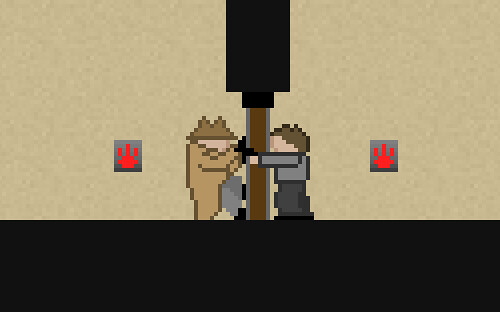 Okay, so neither of us have quite mastered the door technology yet.
Okay, so neither of us have quite mastered the door technology yet.I’ve gone back to working on the infiltration-themed platformer I’m making, Gunpoint. I’d planned to take two days out of the winter break to binge on it, but after a few interruptions I’ve decided four half-days might be more doable, and less exhausting.
The plan is to rapidly impliment the last few features it needs before the main mechanic can make sense, without slowing down to fine tune their operation or tweak the look. So far I’ve got security doors and light switches working, and I’ve almost got the AI interacting with them correctly: only guards can pass through security doors, and they’ll turn on lights if they find them off. Next it’s the main mechanic, then a few last fundamentals that may end up being important.
It’s fun to be making fast progress again. It was a huge mistake to bother putting elevators in before the rest of the basics were working, and the ridiculous time that took added to the ridiculous time AI took is the main reason I ground to a halt on the whole thing.
I now have a game that is ugly, broken and crude in every way except the lifts, which are the most magnificently smooth, reliable and satisfying vertical transportation in the history of interactive entertainment. And I’m about one month behind where I would have been if I’d stuck to stairs. It started to feel hard.
It isn’t, really, but a few things do trip me up repeatedly. I want to make a note of them here on the offchance it gets any of it through my skull, so the rest of this post will make no sense to anyone who doesn’t use Game Maker (the tool I’m making the game with).
Things I Wish I Wouldn’t Constantly Forget
- When you store an instance in a variable – remembering which wall I’ve just collided with, for example – don’t. Store its .id property. Sometimes, even though what you want to reference is a property of that thing, you have to pretend it’s a property of that thing’s id, even though that makes no sense. Otherwise, you get shit like light switches that toggle their own existence on and off instead of changing the light level.
- The Create event is a handy place to put any code that should be executed when the object is created. DON’T EVER FUCKING USE IT FOR THAT. Why? Because the objects in the game at start up are created in an arbitrary, unreadable, undeterminable and randomly changing order.
You have no idea what code has already been done and what hasn’t when any given Create event is executed. So when one tiny change to something suddenly breaks everything in your entire game, including a bunch of stuff it had absolutely nothing to do with, it’s because the Creation order has changed arbitrarily.
Only ever use Create to set initial variables, then use Alarm events to trigger actual code. That way you can set those alarms to go off in the order you specify.
- Often you want one object to ‘trigger’ an event for another object. The reason the method you just tried isn’t working is that it’s getting re-triggered repeatedly sixty times a second all the time that the conditions are fulfilled, usually reversing the effect and/or delaying alarm events indefinitely.
The best way I’ve found to do triggers like this is to have it set an Activate property on the target object. The target object checks this Activate property every step, and the moment it’s ‘true’, it sets it to false, does its work, then tells the trigger object not to bother it again until it needs to.
- Relatedly, attach code to the object it affects, rather than the object that executes it. A button shouldn’t open a door, even if that’s the only thing it’s ever going to do. It should just say “Open!” to the door, and the door itself should contain the code for how to do that. That way, if you ever need other objects to open the door, they can just say “Open!” too and it won’t cause any conflicts or require any repeated code.
Pretty goddamn fascinating, I think you’ll agree. The truth is that most of the problems you encounter creating a game aren’t as frustrating as playing the average shooter. You don’t expect to succeed. You’re wrestling a ridiculous tangle of logical statements into something that functions as a comprehensible world, which is an insane and extraordinary thing to do – even when the results are drab, glitchy and artless. In other words, I’m enjoying it again.
By the end of this sprint I plan to at least be able to show you a video of it in action, and possibly send out a new prototype version to testers. If you’d like to try it when the next version’s ready for testing, and haven’t already mailed me about it, mention Gunpoint in a mail to pentadact@gmail.com.
2010: The Year In Forty Photos
You probably don’t want to hear about my year, particularly since it was good. So I’ll do what I did in 2009 and just pick some shots from it, and a track to listen to while you browse. Continued
Welcome To Site Six
I seem to redesign this place at the start of every year – boredom with the old design peaks just as the winter break hits with the spare time to fix it. This new design is mostly just a visual jiggle, but I’m counting it as site number six because it’s no longer called James. I’m not good with titles, obviously, so it doesn’t really have one anymore – it’s just my blog, or Pentadact.com if you need something more unique.
I’ve sort of decapitated the old design:
It felt flabby and basic, and those black bars bothered me for no good reason. The new one fits more on the screen, and is a bit smoother. You’ll notice I’ve brought it bang up to date with the hottest web trend of 2003 – very slight gradients. A few other things are new:
- Infinite scroll: it loads the next bunch of posts when you scroll to the bottom. It doesn’t currently tell you it’s doing this.
- Like button: fucking Zuckerberg. That ugly little thing is so goddamn hard to put on any non-white page without making it hideous. I can’t resist them, though – they’ve been awesome on the PC Gamer site for letting us know the difference between pieces that people want to respond to, and piece people just… like. Without something filling that role, you never really know when you’ve done something right.
- Category tabs: browsing by category was a little obfuscated in the last design. I wanted to put them front and center for the sake of people who don’t care about games, since that topic often dominates this place a bit. Of course, which category link do the vast, vast majority of people click on? Games. They look at my site about games and think “Goddamn it, this isn’t enough about games! ONLY GAMES!”
As ever, please let me know what you think and if anything isn’t displaying right for you. I have some tweaking to do and presumably a lot of bug fixing, though it doesn’t look too disastrous so far.
Construction Ahead
Please excuse the state of this place while I tinker with it a little. I have a visual retartening planned out, and the current design will start to look glitchy as I rip it up and force the new one in. I’ll let you know when it’s supposed to look right, and you can tell me that it really doesn’t.
Old Year Resolutions
Christmas is over, I’m home, and I have a bit of time before I go back to work. My resolution last year was to be more prolific – take on lots of different stuff, do it all, stop whining. In that spirit, I’m going to try to get a bunch of stuff done. I doubt I’ll manage it all, but here’s the plan.
Work on Gunpoint for two days straight
Making Scanno Domini in 48 hours was exciting and eye opening. The deadline not only sped progress, but forced brutal and useful decisions about the design. I want to do the same for my longer-term game Gunpoint, aiming to get it to the point where you can meaningfully complete a level using the game’s central mechanic by the end of the year.
Every hour of work you put in before that point might be a complete waste of time, so you have to get there as rapidly as possible. I’ll probably work on it on the 29th and 30th.
Redesign Pentadact.com
The intentionally misleading title of this place is starting to cause actual harm in world increasingly reliant on search ranking. I have to call it by my own name. I also want to make the design slightly cleaner and less busy, and implement infinite-scroll rather than those archaic ‘Older posts’ links. Might tweak the colours and add an archive if I have time.
Start ‘Notebook’
A new category or subsite on here for what I used to call philosophy, but which has evolved into increasingly practical advice given by myself to myself. I need to write the shit I figure out down so I don’t forget what little I’ve learned, and doing it publicly helps get it straight in your head.
Post: What Makes Games Good
One I’ve been tinkering with for too long. It’s about giving names to the different metrics on which great games succeed – the ones that really matter. Because they’re not ‘graphics’, ‘gameplay’ and ‘multiplayer’.
Post: What Games Are Bad At
Less of a priority, but I’ve often wanted to do a series on the things I think the industry is repeatedly fucking up. Most of my obsessions about games relate to what they normally get wrong, so explaining why and how might turn that into useful advice for making them better.
Tweak Scanno Domini
So much I could do to this from here, but to avoid letting it distract me from more important stuff, I’ll stick to the quality-of-life essentials. Snow and single-barreled weapons fire both need to be darker – they’re invisibly bright on some people’s screens. Bots still sometimes get stuck camping you, forcing a restart. I really should let you use the keyboard for movement if you want to. And I might either make the game a little easier, add an easy mode, or do something clever with the difficulty so that it ramps up more smoothly. Watching my dad play it was informative.
Christmas 2010
Some pictures from mine. It’s snowy here in England, and the Dorset hills are a nice place to stomp around in it.
I got a Kindle! If you mail me stuffs – anything like a .txt .doc or .pdf – it’ll pop up on my cyberhyperbook! This is the address: pentadact@free.kindle.com

